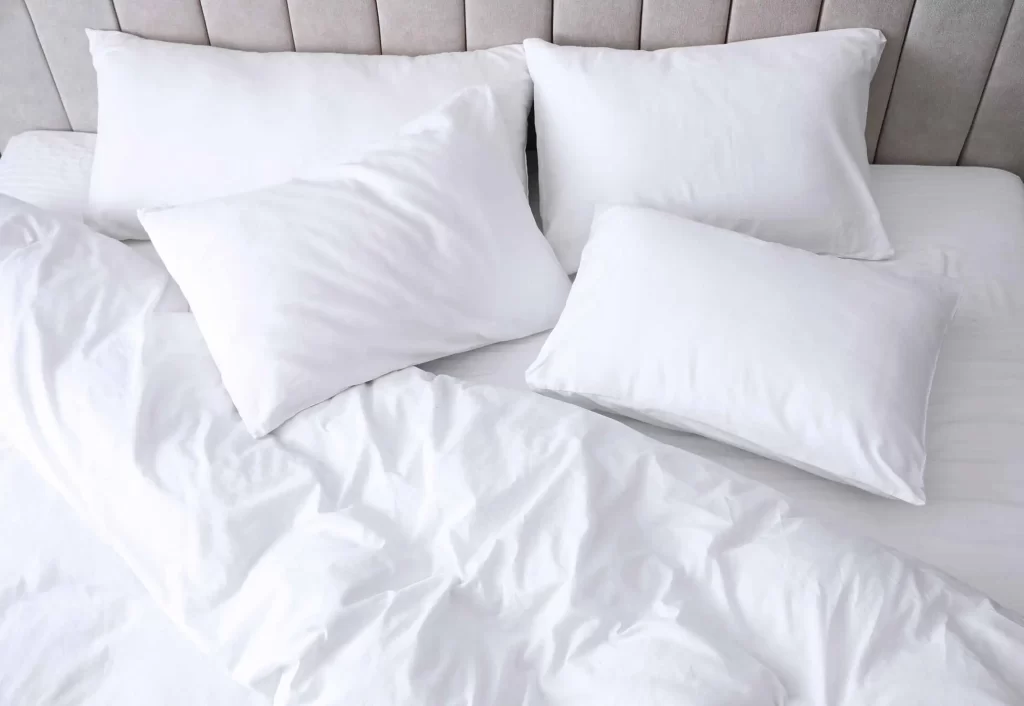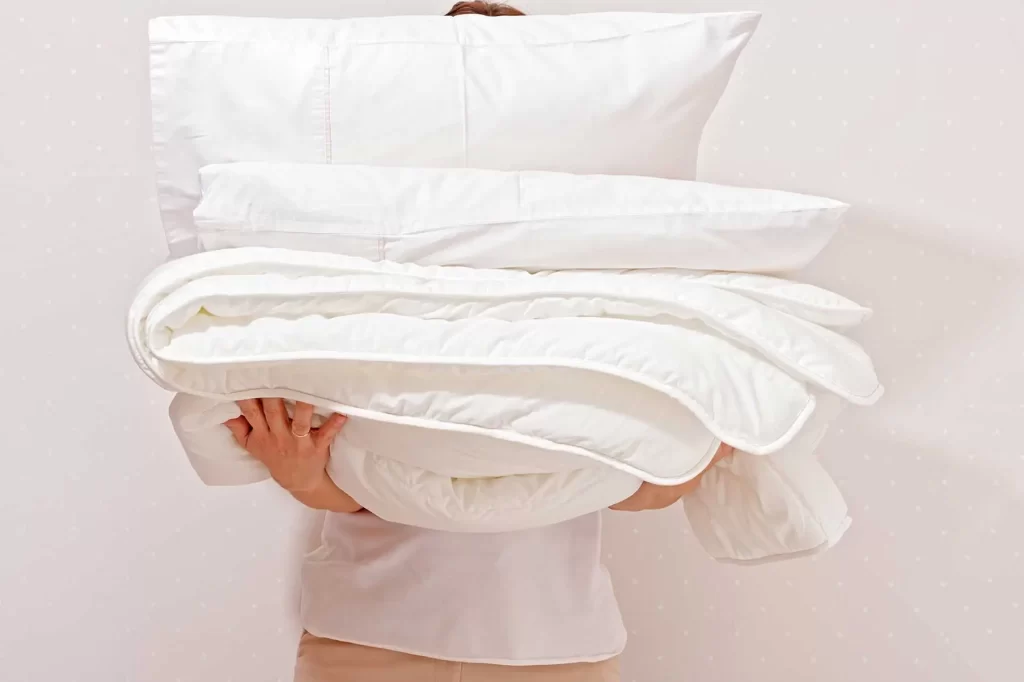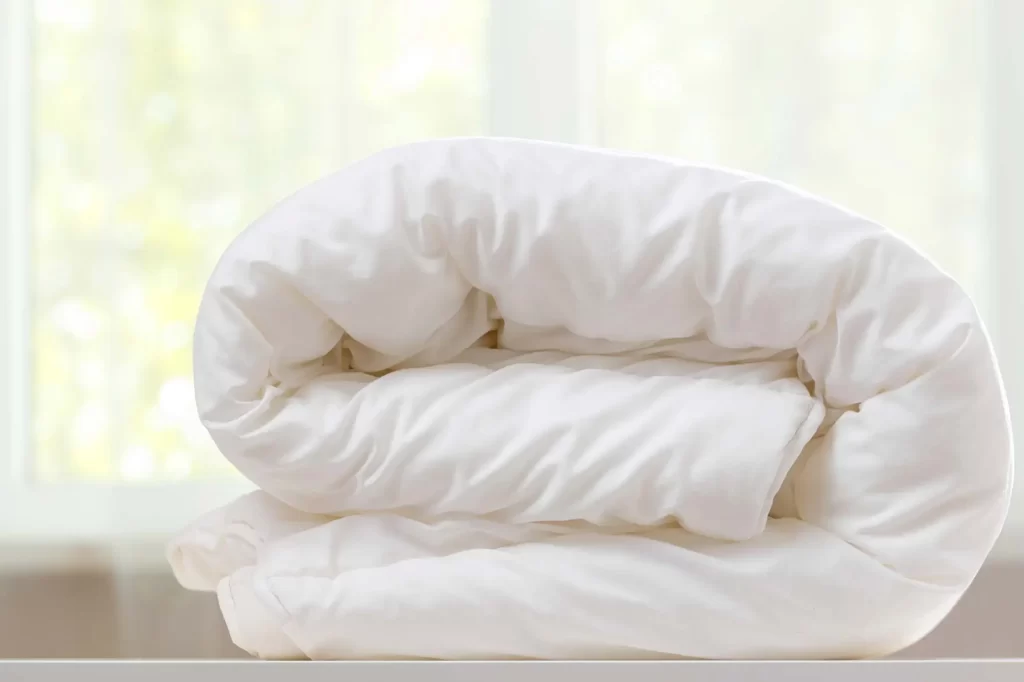Your Complete Duvet Buying Guide You’ll Ever Need
Are you in the market for a new duvet but feeling overwhelmed by all the options? Don’t worry! This duvet buying guide will take you through all the elements to consider when buying a duvet, from size and filling to fabric and design.
Find the perfect duvet for your bed by learning everything you need to know.

What is a Duvet?
A duvet is a soft, flat bag filled with feathers, down, synthetic fibres, or a combination of the three, and it is used as a blanket to cover the top of your bed. It has a cover that is either made of polyester or poly cotton fabric to add extra warmth and comfort.
Duvets are typically warmer than traditional blankets and don’t need to be tucked around the bed, making them ideal for colder winter nights. They come in various sizes and can be filled with different materials, such as natural down or synthetic fibers, to suit any preference.
How to Choose the Right Duvet?

Choosing the right duvet for your bed is essential for a good night’s sleep. The key considerations when selecting a duvet are size, tog rating, filling, and thread count. Be sure to measure the dimensions of your mattress before purchasing a duvet and check the tog rating to ensure it will provide the desired warmth level.
You’ll then want to consider whether you’d prefer a synthetic filling, feather filling, or down filling. If you want something more sustainable, natural fillings are often better choices.
Finally, higher thread counts mean the fabric is softer and less likely to form clumps, so pay attention to this when shopping. Let us discuss all these aspects in detail one by one.
Choose a Duvet Size Wisely

When selecting a duvet, the size of your bed is an essential factor to consider as a duvet buying guide. To ensure you get the right fit, measure the width and length of your mattress, then add approximately 40 cm all around.
For example, if your mattress is 180 cm by 200 cm, you should look for a 220 cm by 240 cm duvet. It is also important to note that some manufacturers use slightly different measurements, so always check the label before purchasing. Remember that a too-large duvet may look bulky and not drape appropriately on the bed, whereas one that is too small will only cover part of the bed. So take your time and choose a duvet size wisely for the best results.
Available Sizes
- Single Duvets : 135CM X 200CM
- Double Duvets : 200CM X 200CM
- King Size Duvets : 230CM X 220CM
- Super King Duvets : 260CM X 220CM
Never Ignore the TOG Rating

This rating measures thermal insulation. In its complete form, the “thermal overall grade” tells you how warm your duvet will keep you in winter. TOG ratings indicate how warm a duvet is.
This rating can range from 4.5 to 15, with a lower number providing lighter weight, while higher ratings indicate thicker and more insulating bedding. If you prefer a lighter duvet, look for a lower TOG rating. Before purchasing a duvet, check the label for this information.
What Kind of Duvet Filling will Suit You?

Generally, duvets come with synthetic, feather, or down fillings.
Duvet with Synthetic Filling
Synthetic filling is typically made from polyester, which offers excellent warmth and softness. The advantages of synthetic filling are that it’s hypoallergenic, breathable, and can be easily washed at home.
Synthetic fillings are often less expensive and easier to care for than natural fillings like a feather and down. Synthetic fillings are usually lightweight and easy to clean but may offer more warmth and insulation than natural fillings.
Duvet with Feather Filling
Feather duvets are lightweight and provide a comfortable and cosy sleeping experience. These are also one of the most luxurious options, making them an excellent choice for anyone looking for top notch quality bedding.
The feathers are plucked and sterilised before being placed in the duvet to ensure no allergens remain. The feathers used in feather duvets are generally duck and goose feathers, and they are divided into two categories:
● Cluster feather fillings are more lightweight and create an even layer of warmth across the duvet.
● Swirl feather fillings are more durable and provide more support.
Duvet with Down Filling
It provides excellent insulation, keeps you warm, and has a soft and comfortable feel that many prefer. Down comes from geese and ducks, and the quality varies depending on the type used. The highest-quality down duvets are filled with clusters of fine feathers from geese, while lower-quality versions often use more giant feathers from ducks. Down duvets are more expensive than synthetic ones, but can last many years if cared for properly.
Which Filling is Best: Natural or Synthetic?
Choosing the proper filling for your duvet can be a difficult decision. While both natural and synthetic fillings have advantages and disadvantages, there are several factors to consider when making a choice.
Natural fillings such as feathers and down provide superior warmth and breathability, while synthetic fillings offer a more consistent, budget-friendly option. With natural fillings, you’ll need to pay more attention to the care instructions and perform regular maintenance.
On the other hand, synthetic fillings may need to be replaced more often, but require little to no maintenance.
Which Thread Count is Best
Thread count is a crucial factor in duvet buying guide when considering which duvet to buy. The thread count of a duvet shell is the number of threads per square inch, and higher thread counts mean a softer and more luxurious feel.
When it comes to duvets, a thread count between 144-200 is usually considered good quality. However, anything over 200 will offer a luxurious feel, while anything below 144 won’t be as soft and comfortable. It’s also worth noting that even though it would be more comfortable, it may only mean it will last longer than a lower count.
Frequently Asked Questions
Duvet Buying Guide : Final Thoughts
When shopping for a duvet, consider what kind of filling, thread count, and size is best for your needs. Choose natural or synthetic filling, depending on your preference. Make sure you don’t ignore the TOG rating, as this will determine how warm or cool your duvet is.







